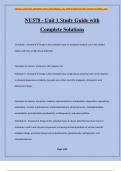EMILLECT 2024/2025 ACADEMIC YEAR ©2024 EMILLECT. ALL RIGHTS RESERVED FIRST PUBLISH OCTOBER, 2024
NU578 - Unit 1 Study Guide with
Complete Solutions
Schedule I - Answer✔✔-Drugs in this schedule have no accepted medical use in the United
States and have a high abuse potential.
Examples are heroin, marijuana, LSD, peyote, etc.
Schedule II - Answer✔✔-Drugs in this schedule have a high abuse potential with severe psychic
or physical dependence liability. Included are certain narcotic analgesics, stimulants, and
depressant drugs.
Examples are opium, morphine, codeine, hydromorphone, methadone, meperidine, oxycodone,
anileridine, cocaine, amphetamine, methamphetamine, phenmetrazine, methylphenidate,
amobarbital, pentobarbital, secobarbital, methaqualone, and phencyclidine.
Schedule III - Answer✔✔-Drugs in this schedule have an abuse potential less than those in
Schedules I and II and include compounds containing limited quantities of certain narcotic
analgesic drugs, and other drugs such as barbiturates, glutethimide, methyprylon, and
chlorphentemine.
Page 1/34
,EMILLECT 2024/2025 ACADEMIC YEAR ©2024 EMILLECT. ALL RIGHTS RESERVED FIRST PUBLISH OCTOBER, 2024
Any suppository dosage form containing amobarbital, secobarbital, or pentobarbital is in this
schedule.
Schedule IV - Answer✔✔-Drugs in this schedule have an abuse potential less than those listed in
Schedule III and include such drugs as barbital, phenobarbital, chloral hydrate, ethchlorvynol,
meprobabmate, chlordizepoxide, diazepam, oxazepam, chloroazepate, flurazepam, etc.
Schedule V - Answer✔✔-Drugs in this schedule have an abuse potential less than those listed in
Schedule IV and consist primarily of preparations containing limited quantities of certain
narcotic analgesic drugs used for antitussive and antidiarrheal purposes.
Absorption - Answer✔✔-Process of drug movement from its site of administration into the
blood
Most common mechanism for drug absorption - Answer✔✔-passive diffusion
First-pass effect
(presystemic metabolism) - Answer✔✔-Rapid hepatic inactivation of certain oral drugs
drug is metabolized (chemically altered) as it passes through either 1) gut wall, and 2) liver.
Distribution - Answer✔✔-drug movement from the blood to the interstitial space of tissues and
from there into cells
Page 2/34
,EMILLECT 2024/2025 ACADEMIC YEAR ©2024 EMILLECT. ALL RIGHTS RESERVED FIRST PUBLISH OCTOBER, 2024
Barriers to distribution - Answer✔✔-- Blood brain barrier
- Placenta
Physiologic Factors Affecting Distribution - Answer✔✔-- Perfusion
- Binding of drug to plasma protein
- Specialized Distribution Barriers
Albumin - Answer✔✔-Binds acidic drugs
Protein (albumin) binding - Answer✔✔-Prevents bound drug molecules from leaving the
bloodstream
Prolongs the distribution phase (Increases half-life)
alpha-1 acid glycoprotein - Answer✔✔-Binds basic drugs
Reservoir effect - Answer✔✔-
Blood-Brain Barrier (BBB) - Answer✔✔-no intercellular pores between brain capillary
endothelial membranes due to the presence of tight junctions between cells
To gain access to the brain from the capillaries, drugs must - Answer✔✔-1) diffuse across cells
(lipid-soluble,
nonionized form)
Page 3/34
, EMILLECT 2024/2025 ACADEMIC YEAR ©2024 EMILLECT. ALL RIGHTS RESERVED FIRST PUBLISH OCTOBER, 2024
or
2) or be actively transported by a carrier
Placental Barrier - Answer✔✔-Transfer of drugs is relatively slow with the
equilibration time between maternal blood and fetal tissues estimated at about 15 minutes for
some drugs and almost an hour for other drugs.
(Virtually every drug used for therapeutic purposes can and does cross the placenta.)
Drugs cross the placenta by - Answer✔✔-diffusion (lipid-soluble, nonionized drugs
penetrate most rapidly.)
Pharmacokinetic Factors
Affecting Distribution - Answer✔✔-- Competition for protein binding sites
- Alteration of extracellular pH
Metabolism - Answer✔✔-Chemical alteration of drug structure
Metabolism - Answer✔✔-Usually produces a polar, water-soluble substance which is more
easily excreted from the body.
Lipid-soluble drugs - Answer✔✔-not easily eliminated by the body's excretory mechanisms
Page 4/34




